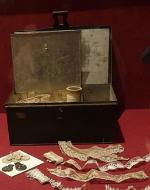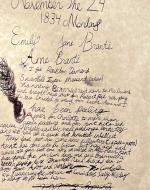Created by Elena Tittel on Sun, 11/13/2022 - 14:35
Description:
It is not esoteric knowledge that the Brontë sisters were skilled novelists and poets; however, the Brontë sisters all also shared a passion for diary writing. All three sisters--Charlotte, Emily, and Anne--kept journals and diaries which they wrote in frequently. Emily and Anne kept some of their diary papers folded up inside a writing box. The first of these notable diary papers is "The First Paper of Emily and Anne, 1834." This was the first diary paper that Emily and Anne wrote together. Like Emily and Anne, Charlotte Brontë also wrote many diary entries that she kept in a journal during her time as a teacher. Aspects of diary writing appear in the sisters' novels. In Wuthering Heights (1847), Catherine Earnshaw engages in diary writing. She mainly does so by writing in the margins of books including her Bible. For Catherine, diary writing serves as an escape. Diary writing plays a pivotal role in The Tenant of Wildfell Hall (1848). The structure of Tenant is in letter and diary form; the main character, Helen, narrates her point of view as an abused wife through a series of diary entries.
Emily Brontë's Writing Box, n.d, The Brontë Parsonage Museum. Emily and Anne Brontë were known for keeping personal diaries. However, some of their diary entries were hidden and kept secret; in particular, Emily kept a tin box given to her as a gift by Branwell Brontë that's original use was for sewing supplies. On the bottom of the box, however, was a secret compartment in which Emily kept folded-up diary entries written by her and Anne. These entries are now referred to as their "diary papers" and were written between the years 1834 and 1845. Emily kept this "secret box" inside of one of her desk boxes--also known as a "writing desk," and consequently, these diary papers were not discovered until after her death. These diary papers are characterized by rather messy handwriting and several punctuation errors. Some of these diary papers contained sketches, a number of which appear to be self-portraits. In fact, one of them contains an image in which Emily is writing at her writing desk, and we can see the tin box pictured on her desk. Today, we see the practice of folding up and storing away texts in containers reflected in some of the sister's novels. Not just that, but some speculate that Emily bought an additional tin box to store her original manuscript of Wuthering Heights.
Elena Tittel, Reproduction of The First Paper of Anne and Emily Brontë from 1834, 2022. For my maker component, I re-created the first page of the first paper of Anne and Emily Brontë. This first diary paper of theirs dates to 1834. In the diary paper, the sisters talk about feeding their pets. The sisters then go on to talk about the Prime Minister, Sir Robert Peel. Lastly, they also mention their older sister, Charlotte, and their Aunt. They depict a humorous interaction between their Aunt and Anne when their Aunt scolds Anne for not having her feet on the floor. They also mention how Charlotte was peeling apples to make pudding. In the diary paper, there is a doodle of a lock of hair that Anne drew. As all letters and papers were made during this time period, we see the diary paper was written in black ink with a Victorian pen. A quick look at the handwriting reveals it is rather messy and hard to read. This letter demonstrates the closeness of Emily and Anne and the sisters' fondness for writing. Emily and Anne went on to write many more diary papers after this first one.
Charlotte Brontë's Journal, 1836, The Brontë Parsonage Museum. While working as a teacher at Roe Head, Charlotte Brontë kept a journal describing her real and fictionalized experiences. She largely talks about her day-to-day life as a teacher. Charlotte did not like teaching, even though she was a teacher for a fair amount of time. This overwhelming sense of contempt she hadt towards teaching is reflected through the language of her entries. Charlotte also writes about her imaginary land that she created with her brother, Branwell Brontë: Angria. In her journal, she creates fantastical scenarios occurring in her made-up land. As per courtesy of the British Library, here is a transcription of this journal page, dated 1836: "What I imagined grew morbidly vivid, ... All this day I have been in a dream, half miserable and half ecstatic: miserable because I could not follow it out uninterruptedly; ecstatic because it showed almost in the vivid light of reality the ongoings of the infernal world. ... Then came on me, rushing impetuously, all the mighty phantasm that we had conjured from nothing to a system strong as some religious creed. I felt as if I could have written gloriously – I longed to write. The spirit of all Verdopolis, of all the mountainous North, of all the woodland West, of all the river-watered East came crowding into my mind. If I had had time to indulge it, I felt that the vague sensations of that moment would have settled down into some narrative better at least than any thing I ever produced before. But just then a dolt came up with a lesson. I thought I should have vomited."
Fritz Eichenberg, "Catherine's Window Scene," from Wuthering Heights (1847), by Emily Brontë, 1943 Random House edition. In Wuthering Heights, we learn much about Catherine's interest in diary writing. Emily Brontë describes how Catherine scribbles in the margins of books, creating miniature diary entries in her Bible, similar to how in real life, Emily doodled in her books and wrote all over them. In the novel, Catherine is described as frequently reading and writing in her window seat. One of the most famous scenes from Wuthering Heights is Catherine's window scene. More specifically, this scene takes place when Lockwood has a dream of Catherine after reading her diary entries. Lockwood falls asleep in her oak closet when suddenly, he hears a noise; when he goes to investigate, he sees the apparition of Catherine's ghost. He describes, "As it spoke, I discerned, obscurely, a child's face looking through the window--Terror made me cruel; and, finding it useless to attempt shaking the creature off, I pulled its wrist on to the broken pane..." (Brontë 21). The symbol of Catherine's ghost appearing in the window represents how Catherine feels shut out from the outside world. Catherine turns to diary writing as an escape and a form of catharsis. Thus, Lockwood "summons" her ghost in the window by reading her diary entries.
Still of "Helen and Gilbert," The Tenant of Wildfell Hall, Director Mike Barke, 1996. Diaries are an extremely important part of The Tenant of Wildfell Hall; in fact, the structure of The Tenant of Wildfell Hall is partly narrated through diary entries by Helen Graham. In the first fifteen chapters of the novel, the narrator is Gilbert Markham. His narration at the beginning of the novel is framed through a series of letters in which he discusses his interactions with a widow named Helen Graham. In this film still from a 1996 production, we see Helen handing her diary to Gilbert. This exchange marks a shift in narration from Gilbert's point of view to Helen's point of view. The majority of the rest of the novel is narrated through the voice of Helen. Helen's narration is framed through a series of diary entries depicting her relationship with Arthur Huntington: her abusive, alcoholic husband. It is not until the very end of the novel that the narration switches back to Gilbert's point of view; the shift back to Gilbert's point of view occurs after Gilbert has read Helen's diary. The function of having the structure be framed through a series of diary entries creates a very personal tone, making the reader feel more connected to Helen andhelping accentuate the portrayal of Helen's relationship with Arthur. Additionally, Helen's diary entries help characterize her as both independent and self-aware, revealing multiple facets of her true self. Having Helen narrate her point of view through a series of diary entries reflects Anne's passion for diary writing as well. To that note, we can see aspects of Anne through the character of Helen, such as the way in which Anne's feminism is funneled through the character of Helen.






